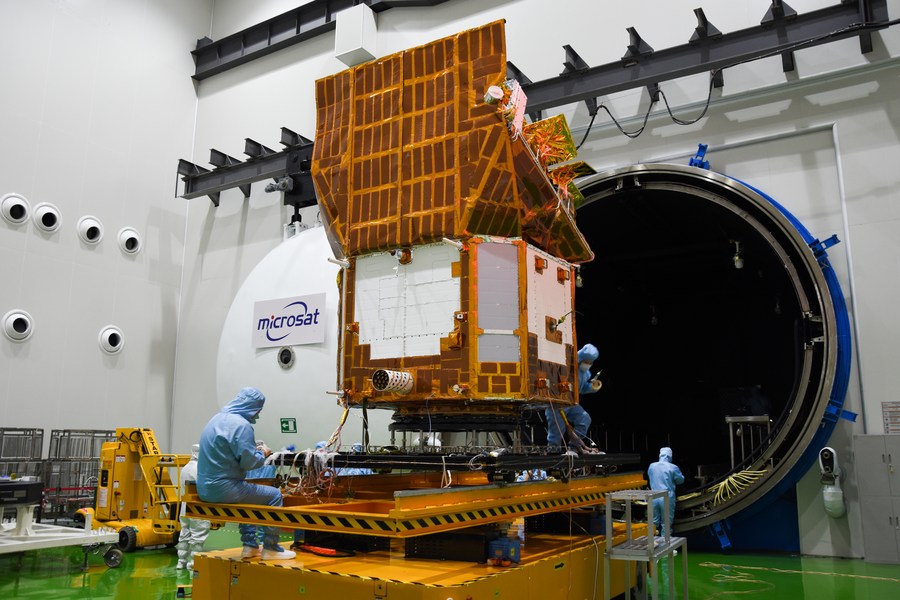Xinhua: Chinese, European Scientists Join Hands to Explore Universe's Mystery
A Long March-2C carrier rocket carrying a new astronomical satellite named Einstein Probe (EP) blasts off from the Xichang Satellite Launch Center
in southwest China's Sichuan Province, Jan. 9, 2024. (Photo by: Zhang Jing/Xinhua)
BEIJING, Jan. 18 (Xinhua) -- A new astronomical satellite, jointly developed by Chinese and European scientists, has been sent into space to explore the mysterious explosive phenomena and study the little-known side of the universe.
The Einstein Probe (EP), launched from the Xichang Satellite Launch Center in southwest China's Sichuan Province on Jan. 9, is an international cooperative mission led by the Chinese Academy of Sciences (CAS), involving the European Space Agency (ESA), the Max Planck Institute for Extraterrestrial Physics (MPE) in Germany and Centre National D'Etudes Spatiales (CNES), the French space agency.
The probe is equipped with a wide-field X-ray telescope (WXT) consisting of 12 modules and a set of two units of follow-up X-ray telescope (FXT).
ESA and MPE contributed the key components of the FXT. ESA is participating in the EP project as a mission of opportunity and has provided support for testing and calibrating the X-ray detectors and the optics of WXT. ESA's ground stations will be used to help download the data, while the French space agency provided a VHF (very high frequency) ground receiving network for the real-time and fast downlink of scientific data, according to the project consortium.
In return, ESA and MPE will get access to 10 percent of the scientific data, and CNES will get 5 percent. The Chinese and European parties have also established a joint team of scientists, which will jointly carry out data analysis and scientific research after the launch.

Researchers conduct an experiment for a satellite named Einstein Probe at the Innovation Academy for Microsatellites of Chinese Academy of Sciences (CAS)
in Shanghai, east China, July 20, 2023. (Innovation Academy for Microsatellites of CAS/Handout via Xinhua)
"International cooperation has provided more opportunities for all parties involved to explore space, and at the same time, it is a process of mutual learning, and mutual benefits can be achieved," said Yuan Weimin, principal investigator of EP.
"I would like to congratulate our colleagues at CAS on the successful launch of an innovative mission that is set to make great strides in the field of X-ray astronomy," said Professor Carole Mundell, ESA's director of science. "At ESA, we value international collaboration to advance science and deepen our understanding of the cosmos. I wish the Einstein Probe team a very successful mission."
"EP will achieve a breakthrough in science through its powerful and novel instrumentation, which requires the combination of European and Chinese expertise. We look forward to the many new discoveries enabled by this successful collaboration," said Kirpal Nandra, director of MPE.
Cooperation between Chinese and European space scientists can be traced back nearly 20 years. China's Double Star space mission collaborated with ESA's Cluster mission in 2005 to achieve six-point coordinated measurements of the Earth's magnetosphere for the first time in human history. The joint international team was awarded the Laurels Team Achievement Award by the International Academy of Astronautics in 2010.
With the continuous development of China's space technology and science, an increasing number of countries are participating in China's space program.
International cooperation with scientists from countries such as Switzerland, Italy, Austria, Britain and Germany has been carried out in a series of China's space science missions including the Dark Matter Particle Explorer, the Quantum Experiments at Space Scale, the Hard X-ray Modulation Telescope, China Seismo-Electromagnetic Satellite and the Advanced Space-based Solar Observatory.
The China-Europe joint space mission, Solar Wind Magnetosphere Ionosphere Link Explorer (SMILE), is scheduled to enter space in 2025, according to Wang Chi, director of the National Space Science Center (NSSC) under CAS.
SMILE is a collaborative science mission between the CAS and ESA to build a deeper understanding of the Sun-Earth link by observing the dynamic interaction between the solar wind and Earth's magnetosphere.
The SMILE mission is a very ambitious cooperation program executed with equal contributions from both entities. It demonstrates the close links between ESA and the NSSC/CAS, said Karl Bergquist, administrator of European and external relations of ESA.
"Space science in China has developed extremely fast in the last 10 years and is now at par with all the leading space powers," Bergquist said.
"Cooperation is very beneficial per se, and in particular when European and Chinese scientists study and work on the same topics, cooperating on mission development will reduce costs and push the scientific boundaries further," Bergquist added.
Source: Xinhua